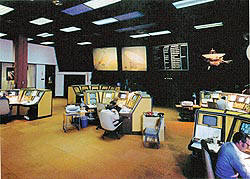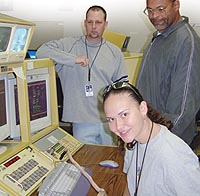|
(This is the second in a two-part series about IBEW members
who work for NASA)
November 2004 IBEW Journal
NASAs Deep Space Communications Complex
in Goldstone, California, is over 2,600 miles from Marylands
Goddard Space Centerwhere members of IBEW Local
1501, in Baltimore, support the development of a robot
that could be assigned to repair the Hubble space telescope.
 Signal
processing center-Goldstone Signal
processing center-Goldstone
At the Goldstone facility on
the Mojave Deserts Fort Irwin Army Base, members of IBEW
San Bernardino, California, Local
543 actually communicate with the "real deal,"
the Mars Rover, robots that are every day returning captivating
details of the red planet. When they are not "uplinking"
to the Rover, Local
543 members track stars, asteroids and planets and man
the listening post for over 30 other spacecrafts, including
the Cassini (Saturn mission). The members are, in the words
of their chief steward, Steve Smith, "can do, go to members
who are making history."
IBEW Members Link Spacecraft
with NASA Scientists
Ray Gibson describes himself
as a "space person." Coming of age in West Virginia
in the late 1950s, he was captivated by the space flights
that emerged from NASAs Goldstone and from the Jet Propulsion
Laboratory (JPL) in Pasadena.
 From
left, Local 543 Lead Console Operators Steve Olson, Anna Schermerhorn
and Glenn Pleasant. From
left, Local 543 Lead Console Operators Steve Olson, Anna Schermerhorn
and Glenn Pleasant.
Today, 57-year-old Gibson, a
member of IBEW Local
543, works at a console inside the signal-processing center
at the Deep Space Communications Complex in direct communication
with the Mars Rover, Cassini and other deep space missions.
"I love this job," says the 32-year veteran of NASA.
"Its important work. I want to let people know what
the space business is doing for them."
The world was enthralled in June
2003 when NASA launched twin robot geologists on a mission
to Mars. When the robots descended onto the surface of the
red planet in January 2004, members of Local
543 received the very first signals from the rovers antennas.
There, in a cold control roommaintained at 68 degrees to
protect the equipmentsurrounded by a horseshoe-shaped bank
of 16 to 25 computer screens, these employees of a NASA contractor,
ITT, became the worlds ears to the space robots. They share
their responsibilities with NASA workers in Canberra, Australia,
and Madrid, Spain, who pick up signals from spacecrafts as
the Earth rotates.
After receiving a signal from
Madrid, the Goldstone crew shares 10 minutes of joint tracking
time with that station before exclusively taking over the
signal. After eight hours, Canberra steps in.
Lorraine Koger, 40, a maintenance
and operations digital operator who has worked at Goldstone
for 14 years says: "IBEW members are go betweens,"
linking the spacecrafts communications systems with the engineers
and scientists at the JPL. Operators work shifts around the
clock, assigned to one of seven antennas, ranging from 34
to 70 meters that resemble huge satellite dishes. They find
the range and direction of spacecrafts, passing the information
on to the experts. "Everything that were doing is educational
for the rest of the world," she says. "We get whatever
we can. We track asteroids, stars and other planets that astronomers
are still trying to identify."
Fast Pace, High
Stress Environment
"We make the decisions.
Then its on us, not the supervisors. This is a very fast
pace, high stress work environment," says Steve Smith,
chief steward, chairman of the 114-member unit and a lead
console operator. The 44-year-old retired Navy radioman says,
"We are totally responsible for the operation."
Smith credits the Goldstone crew for holding up well under
pressure. In line with his description of his members as a
"can do, go to" group, Smith says "we were
the last humans to talk to the Galileo Spacecraft on September
21, 2003, when we sent it into the atmosphere of Jupiter."
Smith serves as a NASA/JPL solar system ambassador, conducting
outreach programs to surrounding communities on the work performed
at the complex.
Pat Carr, ITT Deep Space Technology
operations and maintenance program manager, joins Smiths
praise of the IBEW crews. He says, "the quality of work
since we took over the contract is outstanding. IBEW folks
are hard-working, dedicated team members who have made major
contributions to the success that NASA, JPL and the nation
have enjoyed."
The Goldstone crew monitors over
30 space missions. The administrators of each space project
schedule antenna time through the propulsion lab in Pasadena
and the JPL, in turn, notifies ITT, which assigns work to
operators. Once assigned to an antenna, the 24 lead console
operators load all software and frequencies into the transmitters
and receivers, performing calibrations to make certain that
the antennas are at the proper power level. Once the power
is set, operators transmit or "uplink" to the spacecraft,
using up to 20,000 watts, like a radio over the airwaves,
sending commands or transferring data.
Scott Heck, a 42-year-old maintenance
and operations technician, explains that the spacecrafts have
onboard transmitters that, in most cases, project very weak
signals. NASAs antennas contain cryogenically-cooled low
noise amplifiers that enhance the "downlinked" signals
coming back from space. IBEW members digitize the signals
and then transmit them to the engineers and scientists at
the JPL.
Experts at JPL review the "downlinks"
that have been converted to pictures or engineering data.
In the case of the Rover, the data informs JPL of the state
of onboard equipment. In one instance, engineers detected
a problem with a wheel on the robot. They sent a message back
to ITT for assignment to a lead console operator to be "uplinked"
to the spacecraft to correct the problem. Maintenance and
operations technicians are also responsible for conducting
immediate repairs on the antennas at Goldstone if they malfunction.
Each lead console operator can
track two or three spacecrafts simultaneously, using one antenna.
On occasion, the California NASA workers have stepped in to
monitor other missionsincluding the Hubble space telescopewhen
they incurred technical problems.
More>> |

